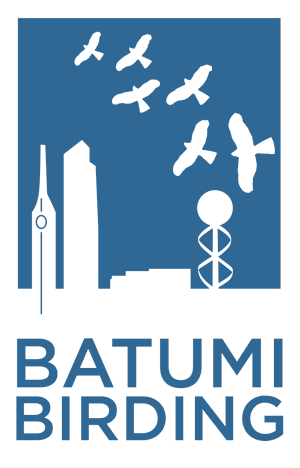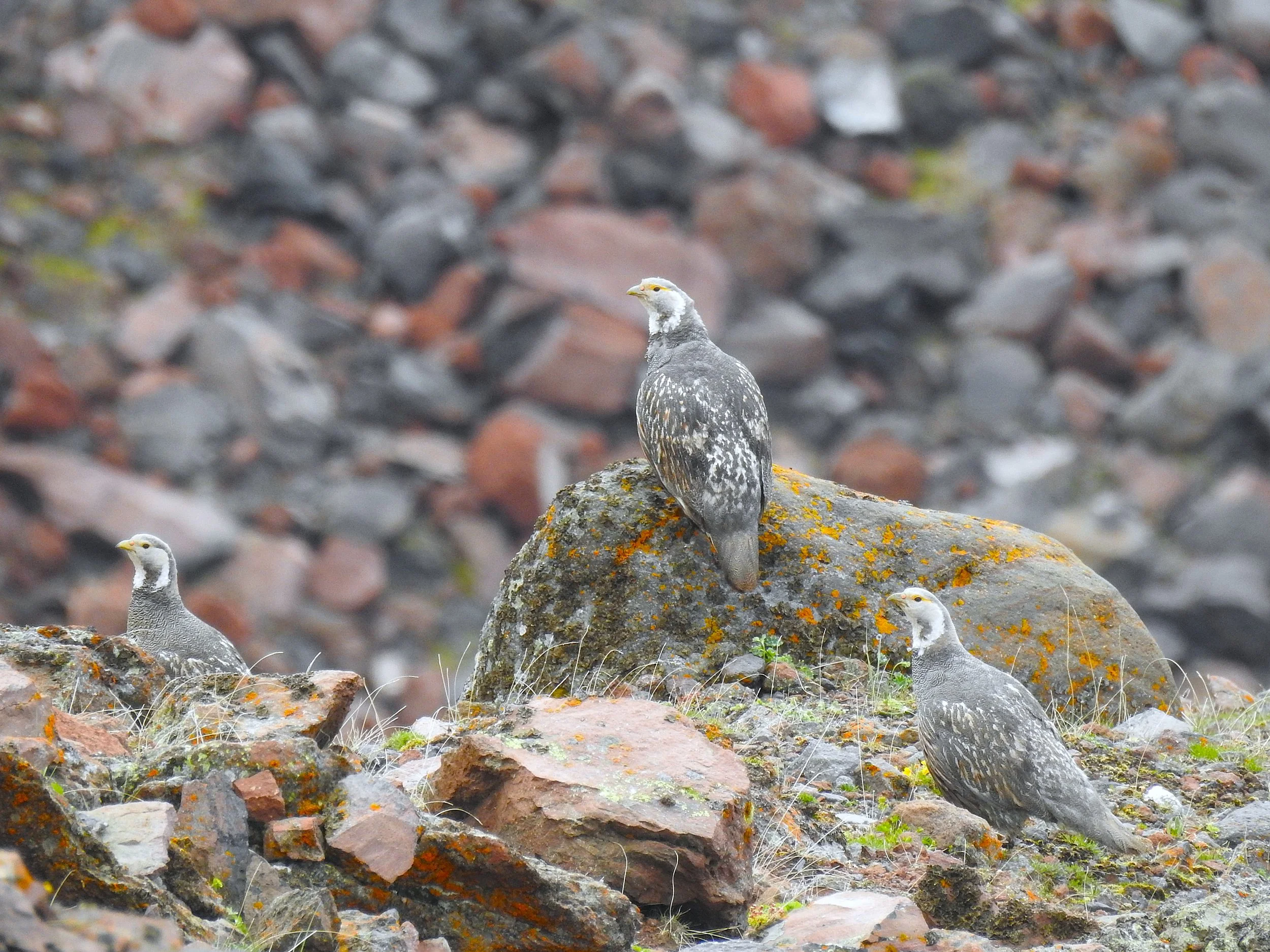Note: This tour is a pilot program, and certain aspects may evolve based on participant feedback and conditions.
On this trip, we aim to get all the good breeding birds of the Caucasus. First, we go for the endemics of the Greater Caucasus and other mountain species at Kazbegi, then we briefly explore the steppes of East Georgia, before finally heading down to Armenia for the specialties of the highlands, along with a selection of fine wetland birds. Ten days of excellent birding, and a trip you will not easily forget! By taking part in this trip, you support the BirdLife partner in Georgia (SABUKO).
Target species
Caucasian Snowcock, Caspian Snowcock, Caucasian Black Grouse, Imperial Eagle, Bearded, Black and Egyptian Vulture, Pygmy Cormorant, White-headed Duck, White-tailed Lapwing, Roller, Blue-cheeked Bee-eater, Bimaculated Lark, Western and Eastern Rock Nuthatch, Kruper’s Nuthatch, Wallcreeper, Rose-coloured Starling, Güldenstadt’s Redstart, Rufous-tailed Bush-robin, White-throated Robin, Persian and Finches Wheatear, Blue and Red-tailed Rock Thrush, Raddes’ Accentor, Semi-collared Flycatcher, Red-breasted Flycatcher, Ménétries’ Warbler, Upcher’s Warbler, Paddyfield Warbler, Moustached Wabler, Green warbler, Mountain chiffchaff, Red-fronted Serin, Great Rosefinch, Rock Sparrow, Pale Rock Sparrow, Crimson-winged finch, White-winged Snowfinch, Black-headed Bunting, Grey-necked Bunting.
Caucasian Black Grouse. Photo by D. Shoshitashvili
Day-by-day program
7 June: Arrival in Tbilisi and Direct Transfer to Kazbegi
Kazbegi. Photo by D. Shoshitashvili.
Upon arrival at Tbilisi Airport, participants will be transferred directly to Kazbegi, where they will check into a hotel for the night. This first day will be dedicated to exploring the surrounding area, allowing us to observe various bird species while preparing for our ascent into the mountains the following morning.
Night in Stepantsminda
8 June: Horseback Ascent to the Mountains
We will begin our day early in the morning. Horses will be waiting near Gergeti church to take us on a scenic two-hour ride to Sabertse. This portion of the journey follows safe and established trails.
Upon reaching Sabertse, we will continue our trek on foot for approximately 40 minutes to 1 hour to reach the Altihut Guesthouse at an altitude of 3,000 meters. Participants should be physically fit and comfortable riding horses, as well as prepared for a manageable hike. While the ascent is generally straightforward, the rapid change in altitude may cause some breathlessness; however, 3,000 meters is not overly challenging.
Accommodations at Altihut
At the Altihut Guesthouse, our focus will be on observing target species such as the Caucasian Snowcock, Great Rosefinch, and Güldenstadt’s Redstart, among a few others. These specialties are often found nearby, providing excellent opportunities for observation and photography.
Great Rosefinch at Altihut. Photo by D. Shoshitashvili.
Please note that accommodations at the Altihut consist of shared rooms either 3-4 person rooms or one large room accommodating up to 18 people. There are shared toilets available, but no showers, so participants should plan for a two-day stay without the opportunity for a shower.
Night in Altihut
Güldenstadt’s Redstart at Altihut. Photo by D. Shoshitashvili.
9 June: Birdwatching Around Altihut
Once settled, we will engage in birdwatching in the immediate area, focusing on our target species, which can often be observed at close range. The breathtaking mountain scenery enhances this unique experience.
Night in Altihut
10 June: Return Journey
The following day, we will make our way back, which takes approximately four hours. While the descent is less strenuous, participants should be mindful of the pressure on their knees due to the extended hike.
We will head back to our hotel for lunch and much needed shower. Later drive back towards Tbilisi visting Kojori Forest, where we will search for Krüper's Nuthatch.
Night in Tbilisi
11 June: Davit Gareji Monastery Complex
Rosy Starling Flock. Photo by Dom Standing.
East of Tbilisi, a vast semi-arid landscape unfolds, featuring steppes, rocky outcrops, shallow lakes, and riverine forests. Our first stop will be Krstanisi Forest, which is home to six woodpecker species: Syrian, Black, Green, Lesser Spotted, Middle Spotted, and Great Spotted. Additionally, we may encounter nesting Golden Orioles and Levant Sparrowhawks.
Continuing eastward, we will visit the rock monasteries of Davit Gareji, passing through steppes where significant populations of Rose-Coloured Starlings, Tawny Pipits, Pied Wheatears and Calandra Larks breed.
Night in Tbilisi
Armenian Part of the Tour
12 June: Tbilisi to Dilijan Forests and Lake Sevan
Dilijan National Park, covering 24,000 hectares, is located in the northeastern part of Armenia. Here, we may spot Semi-collared Flycatcher, Golden Eagles, Lesser Spotted Eagles, Booted Eagles, Common Buzzards, European Honey-Buzzards, Eurasian Sparrowhawks, Great Spotted Woodpeckers, and many other forest species. Huge breeding colony of Armenian gulls in Lake Sevan.
Night in Sevan
13 June: Sevan to Vardenyats Pass (Selim Pass) to Noravank Gorge to Yeghegnadzor
The Vardenyats Mountain Pass (2,410 m) connects the historical Gegharkunik with the Vayots Dzor region. It is an interesting spot for Ortolan Buntings, Ruddy Shelducks, Common Rosefinches, Common Rock Thrushes, Bearded Vultures, and various raptors. If we are fortunate, we may even see Radde’s Accentor, Snowfinches, and Bluethroats. Noravank offers Eastern and Western Rock Nuthatch, Red fronted Serin, Golden Eagle, Bearded Vulture, Red-billed Chough
Night in Vayots Dzor
14 June: Yeghegnadzor to Snowcock Site to Vedi Gorge
Grey-necked Bunting
In the early morning, we will search for our target species, the Caspian Snowcock, in the Yeghegnadzor Mountains. We will spend much of our time in the high mountains to spot the Snowcock, while also keeping an eye out for Northern Wheatears, Alpine Swifts, Eurasian Skylarks, Meadow and Water Pipits, Alpine Accentors, Dunnocks, Rosefinches, and Peregrine Falcons.
Vedi Gorge, characterized by its semi-desert vegetation and rocky slopes, is home to rarities such as Egyptian Vultures, Long-legged Buzzards, Short-toed Eagles, Grey-necked Buntings, Trumpeter and Desert Finches, Pale Rock Finches, Eurasian Nuthatches, Rollers, Blue Rock Thrushes, and Finsch’s Wheatears, as well as European Bee-eaters.
Night in Yerevan
15 June: Yerevan to Armash to Oorts Mountains
Armash Fish Farms host a variety of birds, including Pygmy Cormorants, Ferruginous Ducks, White-tailed Lapwings, Glossy Ibises, Blue-cheeked Bee-eaters, European Rollers, Eurasian Spoonbills, Marbled Teals, and White-headed Ducks, along with many other waterbird and songbird species. The Oorts Mountains, located not far from Armash, feature semi-desert landscapes with rocky outcrops and host numerous interesting species, such as Griffon and Bearded Vultures, Chukars, Eastern and Western Nuthatches, Woodchat and Red-backed Shrikes, and Red-fronted Serins. If we are lucky, we may spot the Persian Wheatear, one of Armenia's rarities.
Night in Yerevan
16 June: Yerevan to Aragats to Amberd
Armash marshes
On our journey to Aragats, we will take the opportunity to observe the Bimaculated Lark.
Mount Aragats, standing at 4,090 meters, is the highest point in Armenia and an excellent area for observing woodland, meadow-steppe, and sub-alpine species. Here, we may encounter Radde's Accentors, Rock Thrushes, Ring Ouzels, and White-throated Robins in the sub-alpine zone, while species like Alpine Accentors, Horned Larks, and Red-billed Choughs are common in the boulder fields. Raptors such as Common Buzzards, Steppe Buzzards, Eurasian Sparrowhawks, and Lesser Spotted Eagles can be seen soaring above the woodlands, while Snake Eagles and Black Kites frequent the meadow-steppe regions. The cliffs surrounding the crater also provide habitat for Wallcreepers and Bearded Vultures. Amberd, a 7th-century Armenian fortress located at 2,300 meters above sea level, provides a stunning backdrop for our explorations.
Night in Yerevan
17 June: Departure
After a final celebratory evening, we’ll ensure that all participants catch their flights back home. For those preferring to book a return flight from Tbilisi, transfers will be organized.
When
7 to 17 June 2026
Price & Booking
Price includes all accommodation with full board, transport, guides, entrance fees. We will stay in basic but clean and comfortable hotels with shared bathrooms. If you prefer to have a single room, a supplement of 300 EUR applies.
Please contact us for detailed information about the prices using the form below or by sending an email to info@batumibirding.com.


